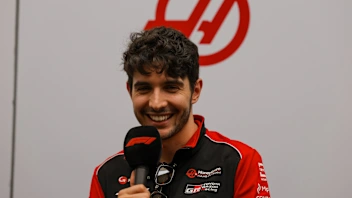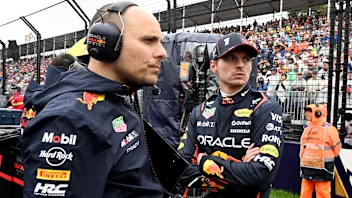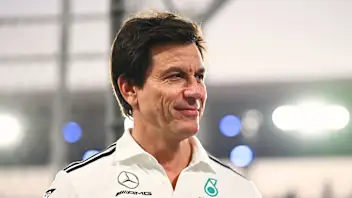Moments in time - the Canadian Grand Prix
In our series exploring the history of Grands Prix through a selection of iconic images, we focus the lens on Canada. This trip down memory lane takes in all three venues to have hosted the race and includes several bold wet-weather drives, plenty of last-lap drama, a couple of major shunts, and more…
A soggy start for F1 racing in Canada, Mosport, 1967
Lotus’s Jim Clark leads the field away in dingy conditions at the start of the inaugural world championship Formula One race in Canada in 1967. Clark, driving the iconic Lotus 49, lost the lead to Brabham’s Denny Hulme early on, but as the undulating Mosport track dried he slowly moved back to the front before re-taking P1 on lap 58. But it wasn’t to be the Scotman’s day as his engine cut out on lap 68, handing the race to Jack Brabham who had just overtaken team mate Hulme.
(© Sutton Images)
Braced for bad luck, Mont-Tremblant, 1968
Between 1967 and 1970, Mosport alternated Canadian Grand Prix hosting duties with the similarly spectacular, similarly undulating Mont-Tremblant circuit in Quebec. This photo, taken during the early stages of the 1968 race, shows the perennially unlucky Chris Amon leading Jo Siffert around the picturesque tree-lined track. Both men would fail to finish - Siffert lost second place when his privately-entered Lotus developed a fuel leak on lap 29, while the transmission on Amon’s race-leading Ferrari 312 failed less than 18 laps from the chequered flag. The New Zealander never would win a world championship race.
(© LAT Photographic)
Safety car confusion delays podium ceremony, Mosport, 1973
Peter Revson looks determined to hold on to the winner’s trophy in this picture, and little wonder as it ended up being several hours before the Canadian Grand Prix organisers finally declared him the victor of the 1973 race. The delay was caused by a poorly-administered safety car that was sent out following a clash between Francois Cevert and Jody Scheckter on lap 33. The pace car failed to pick up the leaders, confusing the timekeepers and allowing several drivers to make substantial time gains. When the race resumed Shadow’s Jackie Oliver (wearing the white cap in this picture) was in the lead, but he was soon picked off by Revson. Lotus’s Emerson Fittipaldi (pictured left, with hand over mouth) finished second after passing Oliver in the closing stages, though he had led before the safety car mix-up...
(© Sutton Images)
Villeneuve’s perseverance pays off, Montreal, 1981
The man after whom the Ile-Notre Dame circuit is now named - Gilles Villeneuve - saved some of his finest performances for his home race. He took the first Grand Prix win of his career at the inaugural event in Montreal in 1978, but equally as impressive was his drive to third in 1981. The Canadian driver sustained the significant front wing damage visible in this picture after running into the back of Rene Arnoux’s Renault on the first lap of the rain-afflicted race. But whereas other drivers might have dropped back or even retired with such an issue, Villeneuve simply drove around the problem, eventually nursing his Ferrari 126CK home in a podium position.
(© LAT Photographic)
Last lap drama costs Mansell victory, Montreal, 1991
Nigel Mansell (left, red cap) and his race engineer David Brown (right, blue jumper) hang their heads dejectedly after the Briton’s dramatic last-lap retirement from the lead in the 1991 Canadian Grand Prix. Mansell had been the class of the field for 68 and a half laps, but midway around the 69th and final tour his Renault-powered Williams suddenly slowed. As the moustachioed racer ground to a halt at the side of the track, arch rival Nelson Piquet swooped past in his Benetton to complete an unlikely victory. So what had caused Mansell’s sudden demise? The official explanation was a transmission failure, though cynics suggested the Williams driver had stalled his car after letting his engine revs drop whilst waving to fans at the hairpin…
(© Sutton Images)
Alesi finally wins - at the 91st attempt, Montreal, 1995
Jean Alesi burst onto the F1 scene with a series of sensational drives for Tyrrell that suggested he’d be a multiple F1 winner. But through a combination of bad luck and mediocre machinery, the mercurial Frenchman only reached the top step of the podium once - in Canada in 1995. Ironically, on this occasion Alesi was the beneficiary of someone else’s bad luck, specifically Michael Schumacher’s. The German had dominated the race, but 11 laps from the flag his Benetton developed an electrical problem, allowing Alesi through to claim one of the most universally-cheered wins of all time. Shortly after this finish line photo was taken the French-Sicilian’s scarlet Ferrari ground to a halt. Fittingly Schumacher was on hand to give Alesi - who turned 31 on the day of the race - a memorable lift back to the paddock on the back of his rejuvenated car.
(© Sutton Images)
Wurz makes spectacular first-corner exit, Montreal, 1998
The 1998 race in Montreal was blighted by not one, but two spectacular first-corner crashes. The first - and slightly more spectacular - of the multi-car shunts ended with Alex Wurz’s Benetton (minus its front wheels) taking to the air before barrel rolling into the Turn 1 gravel. The second accident, which took place at the re-start, involved the car pictured on the left - Jarno Trulli’s Prost. Once again, close-quarter squabbling in the midfield pack was to blame for the incident which saw Trulli’s car coming to rest on top of Jean Alesi’s Sauber. Wurz, in a spare car, managed to survive the chaos this time, and ended up coming home in a strong fourth place.
(© Sutton Images)
Schumacher siblings create history with famous one-two, Montreal, 2001
In 2001, the battle for victory in Montreal took on a new dimension: it wasn’t simply driver against driver, team against team - it was brother against brother. In the red corner was Ferrari’s Michael Schumacher; in the white his younger brother, Williams’ Ralf Schumacher. For much of the race (and in this picture) it was Michael who led, but Ralf had the last laugh, using a superior fuel strategy to jump ahead at the final stops. The result marked the first time in F1 history that two siblings had finished on the same podium - something the Schumacher brothers would emulate two years later at the same track, albeit with Michael getting the upper hand.
(© LAT Photographic)
Kubica survives horror smash, Montreal, 2007
It’s a testament to Formula One safety that BMW-Sauber’s Robert Kubica was able to escape from this monumental crash in the 2007 Montreal race with nothing more serious than light concussion and a slightly sprained ankle. The accident happened on lap 26 as the Pole tried to pass Jarno Trulli’s Toyota approaching the Turn 10 hairpin. The pair made contact and almost immediately Kubica’s car jettisoned its front wing and speared violently towards the outer retaining wall. It was later revealed that Kubica’s car had impacted the wall at 230 km/h, with the G-forces peaking at an astonishing 75 G - little wonder he had to sit out the race that followed at Indianapolis. His replacement for that event? A young man by the name of Sebastian Vettel…
(© LAT Photographic)
The race of Jenson Button’s life, Montreal, 2011
As a spectacle, the 2011 race in Canada had everything - heavy rain, safety cars, more rain, a lengthy delay, a host of on-track clashes and loads of overtaking including a last-lap change of lead. The man in the thick of all the action was McLaren’s Jenson Button (pictured right, looking ecstatic) who tangled with team mate Lewis Hamilton, received a drive-through penalty and occupied every position on track in a chaotic race which was only settled halfway around the final lap when the Englishman’s relentless pursuit of long-time leader Sebastian Vettel (pictured left, with a disbelieving look on his face) pressured the German into an uncharacteristic error. In a word: epic.
(© Sutton Images)
Next Up
Related Articles
 Getting to know the real Esteban Ocon
Getting to know the real Esteban Ocon Verstappen pays tribute to Lambiase after ‘emotional year’
Verstappen pays tribute to Lambiase after ‘emotional year’ Wolff calls Abu Dhabi ‘mediocre’ but ‘pleased’ to finish P2
Wolff calls Abu Dhabi ‘mediocre’ but ‘pleased’ to finish P2.webp) VOTE: Choose your favourite race of the 2025 season
VOTE: Choose your favourite race of the 2025 season All the key stats from Norris’ title-winning season
All the key stats from Norris’ title-winning season F1 AcademyFerrari sign Larsen for 2026 F1 ACADEMY campaign
F1 AcademyFerrari sign Larsen for 2026 F1 ACADEMY campaign